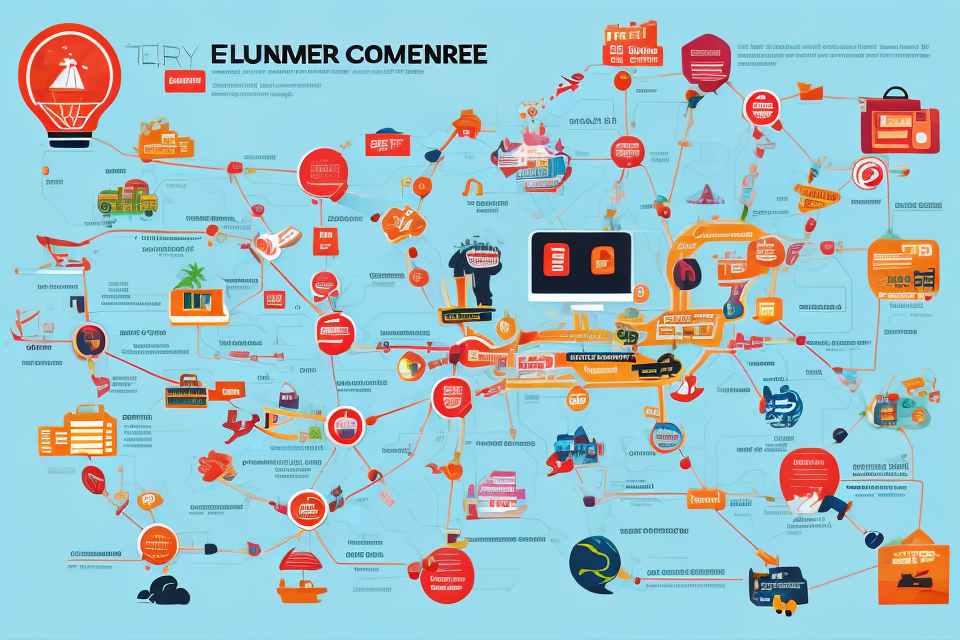Welcome to the world of e-commerce! In today’s digital age, online shopping has become a convenient and popular way for people to purchase goods and services. E-commerce has revolutionized the way businesses operate and has opened up a vast array of opportunities for entrepreneurs and small businesses.
E-commerce refers to the buying and selling of goods and services online, through websites, apps, or online marketplaces. It has transformed the way we shop, allowing us to browse and purchase products from the comfort of our own homes, without the need to physically visit a store.
In this comprehensive guide, we will delve into the world of e-commerce and explore what it does, how it works, and the benefits it offers to both consumers and businesses. From understanding the different types of e-commerce, to navigating the challenges and opportunities it presents, this guide will provide you with a thorough understanding of the exciting world of e-commerce.
Understanding E-Commerce and Its Significance
What is E-Commerce?
Definition and Explanation
E-commerce, short for electronic commerce, refers to the buying and selling of goods and services, or the transmitting of funds or data, over an electronic network, primarily the internet. In simple terms, it is the process of conducting business transactions through digital channels.
E-commerce encompasses a wide range of activities, including business-to-business (B2B) transactions, business-to-consumer (B2C) transactions, and consumer-to-consumer (C2C) transactions. These activities can include everything from online retail sales to electronic fund transfers, and from online auctions to electronic data interchange (EDI) between businesses.
Key Players and Industries
E-commerce has become an integral part of the global economy, and it is transforming the way businesses operate and consumers shop. Many industries, including retail, travel, banking, and healthcare, have embraced e-commerce, and it has created new opportunities for entrepreneurs and businesses of all sizes.
Some of the key players in the e-commerce space include online marketplaces like Amazon and Alibaba, social media platforms like Facebook and Instagram, and payment providers like PayPal and Stripe. E-commerce has also given rise to new business models, such as subscription services and platform-based businesses, which have disrupted traditional industries and created new ones.
As e-commerce continues to grow and evolve, it is important for businesses and consumers to understand its significance and how it can impact their operations and daily lives.
The Importance of E-Commerce in Today’s World
Advantages for Consumers
E-commerce has revolutionized the way consumers shop, offering a plethora of benefits. First and foremost, it provides consumers with convenience. With the click of a button, individuals can purchase products from the comfort of their own homes, eliminating the need to physically visit a store. Additionally, e-commerce offers a wider range of products and services, allowing consumers to access goods from all over the world. Moreover, e-commerce platforms often provide competitive pricing, enabling consumers to find the best deals and discounts.
Advantages for Businesses
E-commerce has also transformed the way businesses operate, presenting numerous advantages. Firstly, it allows businesses to reach a wider audience, as they can sell their products online to customers from anywhere in the world. Additionally, e-commerce eliminates the need for physical retail spaces, reducing overhead costs. Moreover, e-commerce provides businesses with access to data and analytics, enabling them to better understand their customers and make informed decisions. Furthermore, e-commerce offers businesses the ability to run targeted marketing campaigns, increasing brand awareness and driving sales.
E-Commerce Platforms and Solutions
Types of E-Commerce Platforms
Online Retailers
Online retailers refer to businesses that sell their products or services exclusively through their own website. Examples of popular online retailers include Amazon, Zara, and Sephora. These platforms offer a wide range of products and often provide a personalized shopping experience for customers. They typically have their own inventory management system and fulfillment process, which allows them to control the entire sales process.
Online Marketplaces
Online marketplaces, such as eBay and Etsy, are platforms that allow multiple sellers to list and sell their products on a single website. These marketplaces act as a mediator between buyers and sellers, providing a platform for transactions to take place. They typically charge a commission or fee for their services. Online marketplaces offer a wide range of products and often cater to niche markets.
Social Media Commerce
Social media commerce, also known as social commerce, refers to the sale of products or services through social media platforms such as Facebook, Instagram, and TikTok. Social media commerce allows businesses to sell directly to customers through their social media channels. It often involves influencer marketing and user-generated content, which can help increase brand awareness and drive sales.
Mobile Commerce
Mobile commerce, or m-commerce, refers to the sale of products or services through mobile devices such as smartphones and tablets. Mobile commerce platforms, such as Amazon Mobile and eBay Mobile, allow customers to browse and purchase products directly from their mobile devices. These platforms often offer mobile-specific features such as mobile payments and mobile-optimized websites.
Choosing the Right E-Commerce Platform
Factors to Consider
When it comes to choosing the right e-commerce platform, there are several factors to consider. Some of the most important factors include:
- Business size and needs: Different e-commerce platforms are better suited for businesses of different sizes and with different needs. For example, Shopify is a great option for small businesses, while Magento is better suited for larger enterprises.
- Budget: E-commerce platforms can vary widely in cost, so it’s important to choose one that fits within your budget. Some platforms offer free plans, while others can cost thousands of dollars per month.
- Customization and flexibility: Depending on your business’s specific needs, you may need a platform that is highly customizable or one that offers a lot of flexibility. Some platforms, like WooCommerce, are highly customizable, while others, like BigCommerce, offer a more all-in-one solution.
- Support and resources: Some e-commerce platforms offer better support and resources than others. This can be important, especially if you’re new to e-commerce and need help getting started.
Popular E-Commerce Platforms
There are many e-commerce platforms available, each with its own strengths and weaknesses. Some of the most popular e-commerce platforms include:
- Shopify: Shopify is a popular e-commerce platform that is easy to use and offers a wide range of features, including inventory management, payment processing, and shipping. It’s a great option for small businesses and is highly customizable.
- Magento: Magento is a powerful e-commerce platform that is ideal for larger businesses. It offers a wide range of features, including product management, marketing tools, and customer service.
- WooCommerce: WooCommerce is a popular e-commerce platform that is highly customizable and can be used with WordPress. It’s a great option for businesses that want a lot of control over their online store.
- BigCommerce: BigCommerce is an all-in-one e-commerce platform that offers a wide range of features, including product management, payment processing, and shipping. It’s a great option for businesses that want a more streamlined solution.
When choosing an e-commerce platform, it’s important to consider your business’s specific needs and budget. By taking the time to research and compare different options, you can find the right platform to help your business succeed in the world of e-commerce.
E-Commerce Trends and Innovations
Emerging Technologies Shaping E-Commerce
Artificial Intelligence and Machine Learning
Artificial Intelligence (AI) and Machine Learning (ML) are revolutionizing the e-commerce landscape by enhancing customer experiences, optimizing operations, and streamlining decision-making processes. AI-powered chatbots are providing personalized assistance to customers, while ML algorithms are enabling predictive analytics to forecast trends and improve marketing strategies. By leveraging these technologies, e-commerce businesses can offer more relevant recommendations, enhance search capabilities, and deliver proactive customer support.
Big Data and Analytics
Big Data and Analytics play a crucial role in e-commerce by enabling businesses to analyze vast amounts of data to gain insights into consumer behavior, market trends, and operational efficiency. By harnessing the power of advanced analytics tools, e-commerce companies can make data-driven decisions to optimize pricing strategies, enhance product offerings, and improve supply chain management. Big Data and Analytics also facilitate the identification of potential issues, such as fraud and cyber threats, enabling businesses to implement proactive measures to safeguard their operations and customer data.
Voice Commerce and Virtual Assistants
Voice Commerce and Virtual Assistants are increasingly becoming integral components of the e-commerce ecosystem. With the rise of smart speakers and voice-activated assistants like Amazon’s Alexa and Google Assistant, consumers can now shop hands-free, enabling a more seamless and convenient shopping experience. Voice Commerce is particularly beneficial for hands-free navigation, adding items to shopping carts, and placing orders. Moreover, it offers opportunities for businesses to leverage voice-based marketing and promotions, expanding their reach and enhancing customer engagement.
Augmented Reality and Virtual Reality
Augmented Reality (AR) and Virtual Reality (VR) are transforming the e-commerce landscape by providing immersive and interactive shopping experiences. AR technology allows customers to virtually try on clothes, test makeup, or visualize furniture in their homes without physically handling the products. This helps businesses to reduce returns and improve customer satisfaction. On the other hand, VR technology is being utilized in e-commerce for product visualization, virtual tours, and even virtual reality shopping experiences, providing customers with an enhanced sense of presence and engagement. These technologies offer e-commerce businesses a competitive edge by providing unique and engaging shopping experiences that can differentiate them from traditional brick-and-mortar stores.
The Future of E-Commerce
Predictions and Trends
As e-commerce continues to evolve, several trends and predictions are emerging that will shape the future of online shopping. Some of these trends include:
- Increased focus on mobile commerce: With the growing use of smartphones and tablets, mobile commerce is expected to become an even more significant part of the e-commerce landscape. This means that businesses will need to optimize their websites and mobile apps for mobile devices and develop strategies to target mobile users.
- Personalization and customization: As consumers demand more personalized experiences, e-commerce businesses will need to invest in technologies that allow them to personalize their offerings and provide customized recommendations based on individual preferences and behavior.
- Voice commerce: With the rise of voice assistants like Amazon’s Alexa and Google Assistant, voice commerce is becoming an increasingly popular way for consumers to shop online. Businesses will need to develop strategies to capitalize on this trend and integrate voice search and voice commands into their websites and mobile apps.
Opportunities and Challenges
As e-commerce continues to grow, there are also several challenges and opportunities that businesses will need to navigate. Some of these include:
- Competition: With more businesses entering the e-commerce space, competition is becoming increasingly fierce. Businesses will need to differentiate themselves and develop strategies to stand out from the crowd.
- Security and privacy: As e-commerce transactions become more common, security and privacy concerns are also becoming more important. Businesses will need to invest in robust security measures and communicate their privacy policies clearly to consumers.
- Global expansion: As e-commerce becomes more global, businesses will need to navigate complex regulations and cultural differences to expand their reach internationally.
Overall, the future of e-commerce looks bright, with continued growth and innovation on the horizon. By staying ahead of trends and addressing challenges, businesses can position themselves for success in this rapidly evolving landscape.
Building and Managing an E-Commerce Business
Essential Steps for Starting an E-Commerce Business
Conducting Market Research
Before starting an e-commerce business, it is essential to conduct market research to understand the industry and identify potential competitors. This research should include analyzing market trends, consumer behavior, and identifying gaps in the market that your business can fill.
Identifying Your Niche
Once you have conducted market research, the next step is to identify your niche. This involves determining the specific product or service that your business will offer and identifying your target audience. It is important to choose a niche that is in demand and has a high potential for growth.
Developing a Business Plan
Developing a business plan is a crucial step in starting an e-commerce business. This plan should include your business goals, target audience, marketing strategy, financial projections, and operational plan. A well-developed business plan will help you stay focused and make informed decisions as you build your business.
Building Your Online Presence
In today’s digital age, having a strong online presence is essential for any e-commerce business. This includes creating a website, building a social media presence, and establishing an email marketing campaign. Your online presence should be designed to attract and engage your target audience and promote your products or services.
By following these essential steps, you can set your e-commerce business up for success and navigate the competitive world of online commerce.
Strategies for Growing and Sustaining an E-Commerce Business
Optimizing Your E-Commerce Platform
To grow and sustain an e-commerce business, it is essential to optimize your e-commerce platform. This includes making sure that your website is user-friendly, fast, and responsive. Additionally, you should ensure that your platform can handle a high volume of traffic, and that it has robust security features to protect both your business and your customers.
Marketing and Advertising
Marketing and advertising are crucial for growing and sustaining an e-commerce business. You should have a solid marketing strategy in place that includes a mix of both online and offline marketing tactics. This could include search engine optimization (SEO), pay-per-click (PPC) advertising, social media marketing, email marketing, and more. It is also important to track and measure the success of your marketing efforts to ensure that you are getting the best return on investment (ROI).
Customer Service and Satisfaction
Providing excellent customer service is key to growing and sustaining an e-commerce business. You should have a dedicated customer service team in place to handle inquiries, complaints, and returns. Additionally, you should have a customer feedback system in place to gather and act on customer feedback. This will help you improve your products and services, as well as your overall customer experience.
Adapting to Changes in the E-Commerce Landscape
The e-commerce landscape is constantly evolving, and it is important to adapt to changes in order to grow and sustain your business. This could include keeping up with the latest technology and trends, as well as staying up-to-date on changes in e-commerce regulations and laws. Additionally, you should be prepared to pivot your business strategy if necessary, in order to stay competitive in the market.
Key Takeaways
Importance of Understanding E-Commerce
E-commerce is a rapidly evolving landscape, and it is essential to stay informed about the latest trends, technologies, and consumer behaviors. Understanding the basics of e-commerce, including its history, types, and key players, can help you make informed decisions for your business. Additionally, it is crucial to be aware of the legal and regulatory requirements that apply to e-commerce, such as data privacy and security, taxation, and consumer protection laws.
Choosing the Right Platform and Solutions
Selecting the right e-commerce platform and solutions is critical to the success of your online business. You need to consider factors such as the size and complexity of your business, your target audience, and your budget. Researching and comparing different platforms and solutions can help you make an informed decision. Some popular e-commerce platforms include Shopify, Magento, and WooCommerce, while payment gateways such as PayPal and Stripe are widely used for secure transactions.
Embracing Innovation and Adaptability
In the fast-paced world of e-commerce, it is essential to stay ahead of the curve by embracing innovation and adaptability. This means keeping up with the latest technologies and trends, such as artificial intelligence, machine learning, and mobile commerce, and continuously improving your website and customer experience. Being agile and flexible in response to changing market conditions and consumer preferences can help you stay competitive and thrive in the e-commerce space.
Building a Successful E-Commerce Business
Building a successful e-commerce business requires a well-thought-out strategy, strong execution, and continuous improvement. This includes developing a clear value proposition, creating a user-friendly website, optimizing your products and pricing, implementing effective marketing and advertising campaigns, and providing excellent customer service. Additionally, tracking and analyzing key performance indicators (KPIs) can help you measure your success and identify areas for improvement. Remember, building a successful e-commerce business is an ongoing process that requires patience, persistence, and a commitment to excellence.
FAQs
1. What is e-commerce?
E-commerce refers to the buying and selling of goods and services online through electronic channels. It includes a wide range of activities such as online retail sales, business-to-business transactions, online auctions, and electronic marketplaces. E-commerce has revolutionized the way businesses operate and has become an integral part of the global economy.
2. How does e-commerce work?
E-commerce works by providing a platform for buyers and sellers to connect and transact online. The process typically involves the following steps: a customer browses an online store, selects products they want to purchase, adds them to their shopping cart, proceeds to checkout, and makes a payment. Once the payment is processed, the seller ships the product to the customer. E-commerce platforms use various technologies such as secure payment gateways, inventory management systems, and order processing software to facilitate these transactions.
3. What are the benefits of e-commerce?
The benefits of e-commerce are numerous. Firstly, it provides businesses with a global reach, enabling them to sell their products and services to customers all over the world. Secondly, it reduces the costs associated with traditional brick-and-mortar stores, such as rent, utilities, and staffing. Thirdly, it offers customers a convenient and efficient shopping experience, with the ability to shop from the comfort of their own homes. Finally, e-commerce provides businesses with valuable data on customer behavior and preferences, which can be used to improve marketing strategies and increase sales.
4. What are the challenges of e-commerce?
The challenges of e-commerce include security concerns, such as the risk of fraud and identity theft, as well as the need to ensure the privacy and protection of customer data. Other challenges include managing inventory and shipping, providing excellent customer service, and dealing with the competition from other e-commerce businesses. Additionally, e-commerce businesses must stay up-to-date with the latest technology and trends to remain competitive in the market.
5. How can I start an e-commerce business?
Starting an e-commerce business requires careful planning and research. Firstly, you need to identify a niche or market that you want to target. Then, you need to choose an e-commerce platform that suits your business needs, such as Shopify or WooCommerce. Next, you need to create a website, choose a payment gateway, and set up inventory management and order processing systems. Finally, you need to market your business through various channels such as social media, email marketing, and search engine optimization. It’s also important to provide excellent customer service to build a loyal customer base.



